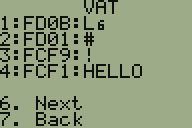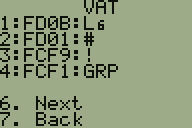Step 6: Calcsys
Calcsys is a very powerful tool, allowing you to mess with the calculator's memory directly. Here's a tutorial on using it to recover things from a corrupted archive.
- Take the name of the program and group you want to recover and convert it to a hexadecimal string. To do that, find each letter in this table and record its column and row. For example, a program named
HELLOwould be 48454C4C4F. Write this down for later use. - Open Calcsys and select
5. Console. It should give you a blank prompt that looks like a homescreen. - Type
SEARCHfollowed by the hex string you just wrote down, then press ENTER. For thatHELLOprogram above, this would beSEARCH 48454C4C4Ffollowed by ENTER.  In a second or so, it should give you an answer in the form ####
In a second or so, it should give you an answer in the form ####,## where the #s are hexadecimal digits (numerical digits or letters from A to F). If it tells youSearch Completeinstead, the variable you're trying to find can't be found, and you can't recover it, so go to step 8 for final instructions. (Sorry.) Otherwise, write the result down. Then press ENTER to see the next result and write it down. Keep doing this until it gives youSearch Completeand returns to the prompt. These numbers are memory addresses. The two #s after the comma are the page number where Calcsys found that instance of the program's name, and the four #s before the comma point to the exact spot of memory on that page (between $4000 and $7FFF). Both numbers are in hex, and don't worry if you don't understand it; you don't need to.- Look through the list and find the entry with the largest page number. If there are several entries on the same page, look for the one with the largest address number. Circle it for reference.
 Type
Type QUITto go back to the main menu. Now select1. Hex Editor. It should greet you with a page full of hex digits and characters. If you've never seen anything of the sort before, don't worry; it's not that confusing once you get used to it, and we'll guide you with screenshots along the way. Press ALPHA > [R]. When it prompts you for a page number, type the two digits after the comma in the entry you just circled.
Press ALPHA > [R]. When it prompts you for a page number, type the two digits after the comma in the entry you just circled. Now press ALPHA > [G]. When it prompts you, type the four digits before the comma in the entry you circled. Calcsys will now jump to that address. See if the characters (starting on the second row) spell out the name of the program or group you're trying to recover. If it doesn't, you probably typed the page or address number wrong, so just try again from the seventh step.
Now press ALPHA > [G]. When it prompts you, type the four digits before the comma in the entry you circled. Calcsys will now jump to that address. See if the characters (starting on the second row) spell out the name of the program or group you're trying to recover. If it doesn't, you probably typed the page or address number wrong, so just try again from the seventh step.- Press LEFT twice and UP twice.
- Find the four hex digits at the very top left of the screen (
4001in this case) and write it down. Draw a box around it for reference. - Press 2ND > [QUIT] to go back to the calculator homescreen.
- If you're recovering a program
-
- Create a program with the exact name as the one you're trying to recover. It doesn't matter what you put in it, so just leave the program blank. All that matters is that the program has to exist before you go on to the next step.
 Go back into Calcsys. This time, select
Go back into Calcsys. This time, select 6. More,1. VAT, then1. Prog/List VAT. If the program's not listed on the screen, press6. Nextuntil it is. Select the program. It should give you a page of information about it.
Select the program. It should give you a page of information about it.- Press ALPHA > [V]. You should be back in the hex editor, but at a very specific spot in memory—the VAT entry of your program.
- Press LEFT five times. The first byte displayed should be "00." Press ENTER to edit it. When it prompts you, type the page number of the entry you circled earlier.
- Press RIGHT once, then press ENTER. Type the first two digits of the address you boxed earlier, not the one you circled.
- Press RIGHT again, then ENTER. Type the last two digits of the address you boxed.
- Press 2ND > [QUIT] to quit to the home screen. Go into 2ND > [MEM] >
2:Mem Mgmt/Del…>7:Prgm…. The program should be archived now. Unarchive it.
The program should be exactly the same as the way it was before your calculator got corrupted. Magic! Now that you got your program back, back it up on another calculator or computer immediately. Then go to step 8 for final instructions.
If your calculator glitched in the last step, it means that that particular program is corrupted. Unfortunately, this means you can't get it back.
- If you're recovering a group
-
- Create a group with the exact name as the one you're trying to recover. It doesn't matter what you put in it, so just select
L1andL2. All that matters is that the group has to exist before you go on to the next step.  Go back into Calcsys. This time, select
Go back into Calcsys. This time, select 6. More,1. VAT, then1. Prog/List VAT. If the group's not listed on the screen, press6. Nextuntil it is. Select the group. It should give you a page of information about it.
Select the group. It should give you a page of information about it.- Press ALPHA > [V]. You should be back in the hex editor, but at a very specific spot in memory—the VAT entry of your group.
- Press LEFT five times. Press ENTER to edit the byte displayed. When it prompts you, type the page number of the entry you circled earlier.
- Press RIGHT once, then press ENTER. Type the first two digits of the address you boxed earlier, not the one you circled.
- Press RIGHT again, then ENTER. Type the last two digits of the address you boxed.
- Press 2ND > [QUIT] to quit to the home screen. Go into 2ND > [MEM] >
2:Mem Mgmt/Del…>8:Group…, then RIGHT toUNGROUP. Ungroup the group.
The variables ungrouped should be exactly the same as they were before your calculator got corrupted. Magic! Now that you got your group back, back up the individual (ungrouped) variables on another calculator or computer immediately. Then go to step 8 for final instructions.
If your calculator glitched in the last step, it means that that particular group is corrupted. Unfortunately, this means you can't get it back.
- Create a group with the exact name as the one you're trying to recover. It doesn't matter what you put in it, so just select


